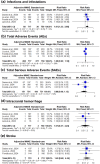Adjunctive middle meningeal artery embolization for non-acute subdural hematoma: A GRADE-assessed meta-analysis and trial sequential analysis on randomized trials
- PMID: 40455367
- PMCID: PMC12129861
- DOI: 10.1007/s00701-025-06574-9
Adjunctive middle meningeal artery embolization for non-acute subdural hematoma: A GRADE-assessed meta-analysis and trial sequential analysis on randomized trials
Abstract
Background and purpose: Non-acute subdural hematoma (NASDH) is a prevalent neurological condition, encompassing chronic and subacute types. Despite standard-care, including surgical evacuation and medical management, recurrence rates remain high. Emerging evidence suggests that middle meningeal artery embolization (MMAE) as an adjunctive procedure may reduce recurrence. This study evaluates the efficacy and safety of MMAE in NASDH.
Methods: A systematic review and meta-analysis of randomized controlled trials (RCTs) retrieved from PubMed, EMBASE, WOS, Scopus, and Cochrane until November 2024. The analysis presented risk ratios (RR) for dichotomous outcomes and mean differences (MD) for continuous outcomes, with 95% confidence intervals (CI) using R software. The GRADE system assessed evidence certainty, alongside trial sequential analysis for result reliability.
Prospero id: CRD42024625504.
Results: Six RCTs and 1,544 patients were included, with an average of 4.7 months follow-up. Adjunctive MMAE, compared to standard-care, significantly reduced hematoma recurrence (8% vs 15.6%; RR: 0.52; 95% CI: [0.37:0.73]; P < 0.01) and surgical rescue (4.5% vs. 12.7%; RR: 0.36; 95% CI: [0.25:0.53]; P < 0.01). However, no significant effect was found for recurrence without surgery (P = 0.94), hematoma volume (P = 0.18), thickness (P = 0.34), or hospital stay (P = 0.37). Infection rates were higher with MMAE (8.4% vs. 4.8%; RR: 1.81; 95% CI: [1.23:2.66]; P < 0.01), but adverse events (AEs), serious AEs, intracranial hemorrhage, stroke, and mortality showed no significant differences.
Conclusion: Adjunctive MMAE reduced hematoma recurrence and surgical rescue rates in NASDH with an acceptable safety profile despite increased infection rates. However, further large-scale trials with extended follow-ups are needed.
Keywords: Brain injury; Clinical trial; Embolization; Neurovascular; Subdural hematoma; Trauma.
© 2025. The Author(s).
Conflict of interest statement
Declarations. Competing interests: The authors declare no competing interests. Ethics Approval: Not applicable. Consent to publish: Not applicable. Consent to participate: Not applicable.
Figures




Similar articles
-
Adjunct middle meningeal artery embolization versus surgery alone for chronic subdural hematoma: A meta-analysis and trial sequential analysis of randomized controlled trials.J Clin Neurosci. 2025 Jul;137:111307. doi: 10.1016/j.jocn.2025.111307. Epub 2025 May 12. J Clin Neurosci. 2025. PMID: 40359787 Review.
-
Middle meningeal artery embolization for chronic subdural hematoma: meta-analysis of three randomized controlled trials and review of ongoing trials.Acta Neurochir (Wien). 2025 Jun 10;167(1):166. doi: 10.1007/s00701-025-06587-4. Acta Neurochir (Wien). 2025. PMID: 40493076 Free PMC article.
-
Middle meningeal artery embolization alone versus combined with conventional surgery in the management of chronic subdural hematoma: A systematic review and meta-analysis.Clin Neurol Neurosurg. 2024 Nov;246:108580. doi: 10.1016/j.clineuro.2024.108580. Epub 2024 Oct 3. Clin Neurol Neurosurg. 2024. PMID: 39395281
-
Added Value of Adjunctive Middle Meningeal Embolization to Surgical Evacuation for Chronic Subdural Hematoma: Comprehensive Meta-Analysis Based on Controlling Confounders.Neurosurgery. 2025 Jun 20. doi: 10.1227/neu.0000000000003588. Online ahead of print. Neurosurgery. 2025. PMID: 40539792
-
Drugs for preventing postoperative nausea and vomiting in adults after general anaesthesia: a network meta-analysis.Cochrane Database Syst Rev. 2020 Oct 19;10(10):CD012859. doi: 10.1002/14651858.CD012859.pub2. Cochrane Database Syst Rev. 2020. PMID: 33075160 Free PMC article.
References
-
- Catapano JS, Koester SW, Srinivasan VM, Rumalla K, Baranoski JF, Rutledge C et al (2022) Total 1-year hospital cost of middle meningeal artery embolization compared to surgery for chronic subdural hematomas: a propensity-adjusted analysis. J Neurointerv Surg 14(8):804–806. 10.1136/neurintsurg-2021-018327 - PubMed
-
- Davies JM, Knopman J, Mokin M, Hassan AE, Harbaugh RE, Khalessi A et al (2024) Adjunctive middle meningeal artery embolization for subdural hematoma. N Engl J Med [Internet] 391(20):1890–1900. 10.1056/NEJMoa2313472 - PubMed
-
- Debs LH, Vale FL, Walker S, Toro D, Mansouri S, Macomson SD et al (2024) Middle meningeal artery embolization following surgical evacuation of symptomatic chronic subdural hematoma improves outcomes, interim results of a prospective randomized trial. J Clin Neurosci 128:110783. 10.1016/j.jocn.2024.110783 - PubMed
Publication types
MeSH terms
LinkOut - more resources
Full Text Sources

